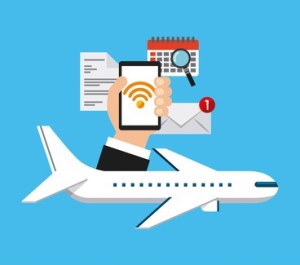According to numerous market studies, in-flight entertainment (IFE) growth is expected to continue to soar. Let’s start this blog with some concrete figures: According to research firm Research and Markets, the IFE and connectivity market is expected to more than double in the next few years, climbing from $2.85 billion in 2015 to $5.8 billion in 2020 – this is a compound annual growth rate of 15.2 percent. And of course, this trend has already been put into motion (again very impressive to see at this year’s the Aircraft Interiors Expo 2016 held in Hamburg). In-flight entertainment (IFE) services are quickly becoming a must-have for airlines and today, in-flight entertainment is offered as an option on almost all wide body aircraft. But this has not always been the case. Years ago, giving passengers access to entertainment during a flight required expensive hardwiring throughout the aircraft cabin. Not only were entertainment choices limited by the content preloaded in the IFE servers, but the systems also added significant weight to aircraft. And with traditional systems, consumers were unable to use their own mobile devices. Now it seems thatthose times are gone forever. Thanks to advancements in technology, today’s IFE systems have come a long way from yesterday’s expensive, inflexible, embedded wired systems. You no longer have to replace the seats and add significant wiring to the cabin. The retrofits require very small, lightweight equipment and wiring and you can install the equipment overnight so that the aircraft is never out of service. And that’s exactly why aviation companies are increasingly turning to wireless technology to create a “connected aircraft” that delivers a whole new set of entertainment and connectivity choices for passengers.
Deploying a wireless system robust enough to support an aircraft IFE system still presents some challenges
In fact, an airplane (you can compare it with a metal tube…) is one of the worst environments for wireless as it is very challenging in terms of signal density. But nevertheless, airlines want equipment that can cost-effectively deliver entertainment and Wi-Fi connectivity to hundreds of passengers. They want technology that fits unobtrusively into the airline cabin and doesn’t add much weight to the aircraft. They require equipment that is certified by the FAA/EASA and international authorities responsible for ensuring the safety of civil aviation. And they want technology that operates seamlessly without any troubleshooting or maintenance required from flight crews. Long story short: The system has to be foolproof. Safety is paramount.

Our customer BAE Systems for example needed a wireless solution that met all the regulatory standards and was already certified for aircraft installation. These standards outline very specific requirements that all avionics hardware must comply with, ranging from power requirements to the ability to withstand certain temperature levels and vibration standards. The equipment must also demonstrate that it does not adversely impact or interfere with any of the aircraft’s onboard electronics. Selecting Kontron’s pre-certified Cab-n-Connect solution – which uses Zebra’s AP 7532 802.11ac access point – gave BAE Systems at least a one-year head start in the market. In this process, BAE Systems also takes advantage of Kontron’s state-of-the-art Systems Integration Lab, which allows both Kontron and our customers to fully test the operation of network equipment, devices and software in environmental conditions that replicate those experienced by aircrafts. And this is of course not a one-off case: Our role in every customer relation is to serve as a trusted technology advisor for our customers. We keep them equipped with the most up-to-date, reliable wireless technology – and of course, help them to find new ways to use it.
How will the future of the IFE look like?
Already now, Kontron’s Cab-n-Connect A100 new access point supports more users, delivers greater bandwidth speeds, offers many additional security (with enhanced radio sensor mode) and management benefits and are backwards compatible with our previous generation CWAP. And the features offered by the WiNG 5 and AirDefensesoftware used on the CWAPs will allow airlines to use wireless technology in many new ways too. For instance, Kontron is talking to airlines about ways how asset tracking and data analytics can make the flight crew and operations support crew more efficient. Here’s one example: Instead of having to manually verify that every seat has a life vest before a flight leaves the gate, vests could be equipped with sensor technology that would alert the wireless network immediately if one were missing. To enhance the customer experience, a wireless sensor in the lavatory could be used so that the system can notify passengers which lavatories are available. Many other types of sensors could be deployed in the cabin and managed by the Kontron A100 wireless system and server in place helping to solve many manual crew challenges while also helping to collect more useful data to provide continuous operational improvements and customer satisfaction. No matter what the future holds, Airlines who embrace this new technology will find themselves riding the tailwind of a whole new wave of innovation.
Read more about how wireless technology is making it easier for airlines to deliver more entertainment choices and better customer service to passengers in our application note “Enhancing the Passenger Experience”, which you can download on our website: http://www.kontron.com/av-bae-blog.

{{comment.comment}}